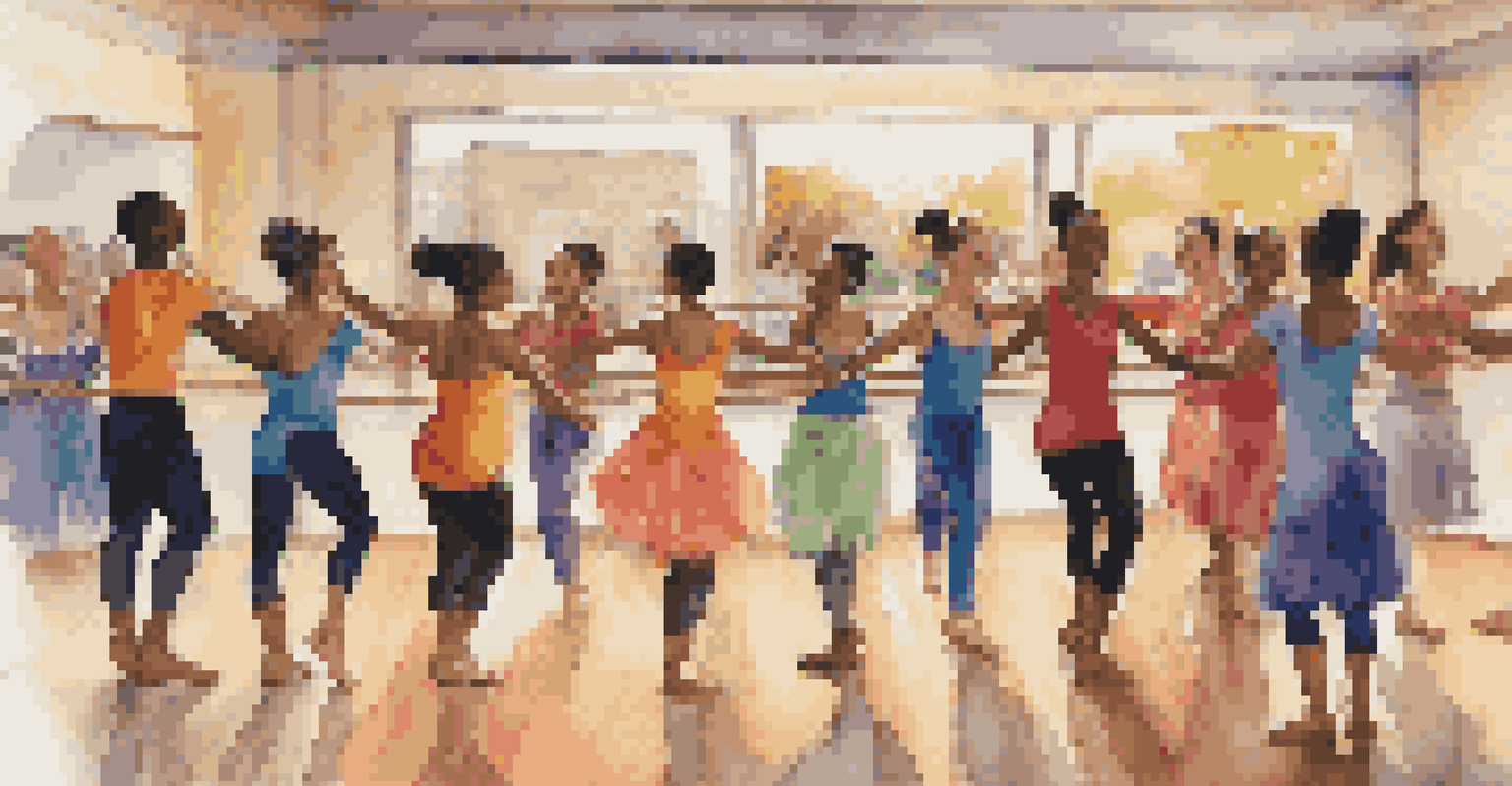Examining the Link Between Perfectionism and Dance Anxiety

Understanding Perfectionism in the Dance World
Perfectionism is often seen as a double-edged sword in the dance community. While it drives dancers to improve and excel, it can also create an unrealistic standard that is nearly impossible to meet. Dancers may feel immense pressure to achieve flawless performances, which can lead to anxiety. This constant quest for perfection can overshadow the joy of dancing itself, causing stress and even burnout.
Perfection is not attainable, but if we chase perfection we can catch excellence.
Many dancers measure their worth by their ability to execute every move perfectly, which can distort their perception of success. For instance, a dancer might feel disheartened after a performance that, to the audience, seemed delightful but fell short of their personal standards. This misalignment between self-expectations and reality often leads to anxiety before and during performances. Understanding this dynamic is crucial for addressing the negative impact of perfectionism.
Ultimately, recognizing the nature of perfectionism can help dancers find a balance between striving for excellence and enjoying their art. By embracing the idea that mistakes are part of growth, dancers can begin to alleviate some of the pressure they place on themselves. This shift in mindset not only fosters a healthier relationship with dance but also paves the way for a more fulfilling experience.
The Role of Anxiety in Dance Performance
Anxiety is a common experience for performers, especially in high-pressure environments like dance. For many dancers, the fear of judgment or making mistakes can manifest as performance anxiety, which may hinder their ability to express themselves fully. This anxiety can be debilitating, affecting not only their performance but also their overall enjoyment of dance. Understanding how anxiety operates is essential for developing coping strategies.

Dance anxiety can present itself in various forms, such as physical symptoms like trembling or sweating, or mental challenges like racing thoughts. This can lead to a cycle where the anxiety about performing creates even more anxiety. For example, a dancer might worry excessively about a particular routine, leading to a heightened state of stress that impacts their ability to practice effectively. Recognizing these patterns can help dancers take proactive steps to manage their anxiety.
Perfectionism Fuels Dance Anxiety
The pursuit of perfection can create a cycle of anxiety for dancers, as unrealistic standards lead to stress and hinder performance.
By addressing anxiety head-on, dancers can learn techniques to ease their nerves, such as visualization, mindfulness, or breathing exercises. These strategies can help ground them in the moment, allowing for a more authentic performance. Additionally, fostering a supportive environment where dancers feel safe to express vulnerabilities can significantly reduce anxiety levels.
How Perfectionism Fuels Dance Anxiety
The interplay between perfectionism and anxiety is often cyclical; one fuels the other. When a dancer holds unrealistic standards for their performance, the fear of not meeting those standards can invoke anxiety. This anxiety, in turn, can lead to overthinking, which may cause mistakes during actual performances. As a result, the dancer feels more pressure to achieve perfection, perpetuating the cycle.
The greatest glory in living lies not in never falling, but in rising every time we fall.
For instance, a dancer who is fixated on achieving a perfect pirouette may become so anxious about executing it flawlessly that they forget to focus on their overall performance. This tunnel vision can diminish their ability to connect with the audience and enjoy the experience. Recognizing this cycle is vital for breaking it and allowing for a more relaxed approach to dance.
Dancers can benefit from shifting their focus from perfection to progress. By setting realistic goals and celebrating small achievements, they can gradually lessen the grip of perfectionism. This shift not only alleviates anxiety but also enhances creativity, making for a more enjoyable dance experience.
The Impact of Social Media on Dance Anxiety
In today's digital age, social media plays a significant role in shaping dancers' perceptions of success. Platforms like Instagram and TikTok often showcase flawless performances, setting a seemingly unattainable standard. As dancers compare themselves to these curated images, it can exacerbate feelings of inadequacy and anxiety. Understanding the influence of social media is crucial for maintaining a healthy mindset.
The pressure to present a perfect image online can lead to a skewed sense of reality, where only the highlights are visible. Many dancers may feel compelled to share their best moments, which can create a cycle of comparison and self-doubt. This phenomenon can be particularly challenging for younger dancers who are still developing their identities and self-esteem. Awareness of this influence can empower dancers to take a step back and critically assess what they consume online.
Social Media Influences Mindset
The portrayal of flawless performances on social media can exacerbate feelings of inadequacy and anxiety among dancers.
Encouraging a more balanced view of social media can help dancers cultivate a healthier relationship with their craft. By following accounts that promote authenticity and vulnerability, dancers can find inspiration without succumbing to unrealistic expectations. Embracing this mindset allows dancers to appreciate their unique journeys, reducing anxiety and enhancing their love for dance.
Coping Strategies for Dance Anxiety
Finding effective coping strategies is essential for dancers struggling with anxiety. Simple techniques, such as deep breathing or positive affirmations, can help calm nerves before a performance. Additionally, establishing a pre-performance routine can create a sense of familiarity and control, helping to ease anxiety. By integrating these practices into their preparation, dancers can feel more grounded and focused.
Another approach is to engage in open conversations with fellow dancers about anxiety and performance pressures. Sharing experiences and strategies can foster a sense of community and make dancers feel less isolated in their struggles. For instance, group discussions or workshops can provide valuable insights and support. This collective approach can empower dancers to confront their anxiety head-on.
Finally, seeking professional help from a therapist or counselor can be beneficial for those dealing with severe anxiety. Mental health professionals can provide tailored strategies and tools to navigate the complexities of performance anxiety. Ultimately, prioritizing mental health is just as important as physical training in the pursuit of dance excellence.
Redefining Success in Dance
Redefining success is a pivotal step for dancers looking to alleviate anxiety. Instead of measuring success solely by perfection, dancers can embrace personal growth and enjoyment as indicators of achievement. This mindset shift allows for a broader understanding of what it means to be successful in dance. By focusing on progress rather than perfection, dancers can foster a more positive self-image.
For example, a dancer might celebrate mastering a difficult routine, regardless of the minor mistakes made along the way. This recognition of effort and improvement can create a more fulfilling experience. Additionally, acknowledging the emotional and expressive aspects of dance can enhance the overall performance experience, allowing for a deeper connection to the art form.
Supportive Communities Matter
Building a supportive community helps dancers feel safe to express vulnerabilities, reducing the isolation that often accompanies anxiety.
By setting personal goals that emphasize creativity and self-expression, dancers can navigate their journeys with greater confidence and joy. This redefined perspective not only eases anxiety but also enhances the love for dance itself. Ultimately, success can be seen as a personal journey, rather than a destination.
The Importance of Supportive Communities
A supportive community can make a significant difference in a dancer's experience with anxiety and perfectionism. Surrounding oneself with encouraging peers, mentors, and teachers creates an environment where dancers feel safe to express their vulnerabilities. This sense of belonging can help alleviate the isolation that often accompanies anxiety. Building these connections is essential for fostering resilience in the face of performance pressures.
For instance, dance studios or schools that prioritize mental health and well-being often see improved morale among their students. Encouraging open dialogue about challenges can help normalize feelings of anxiety, making it easier for dancers to seek help when needed. Additionally, participating in group activities or performances can strengthen camaraderie and provide invaluable support.

Creating a culture that values collaboration over competition can also reduce the pressure to be perfect. By celebrating each other's successes and supporting one another during challenges, dancers can cultivate a sense of unity. Ultimately, a strong support network can empower dancers to navigate the complexities of perfectionism and anxiety more effectively.